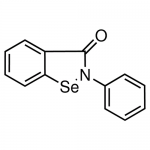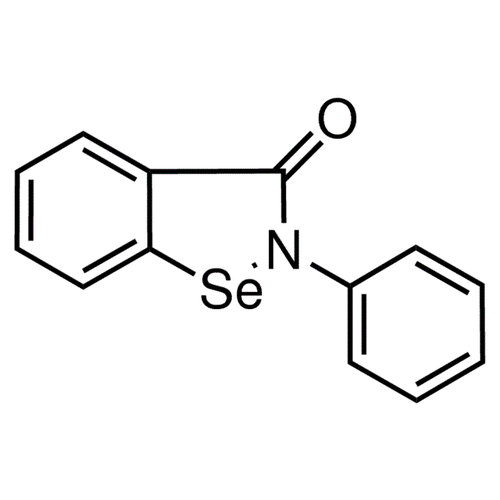| Product Name | Ebselen |
| Description |
Glutathione peroxidase mimic |
| Purity | >99% |
| CAS No. | 60940-34-3 |
| Molecular Formula | C13H9NOSe |
| Molecular Weight | 274.18 |
| Field of Use | Not for use in humans. Not for use in diagnostics or therapeutics. For in vitro research use only. |
Properties
| Storage Temperature | -20ºC |
| Shipping Temperature | Shipped Ambient |
| Product Type | Inhibitor |
| Solubility | Soluble in DMSO and 100% ethanol |
| Source | Synthetic |
| Appearance | Off-white Solid |
| SMILES | C1=CC=C(C=C1)N2C(=O)C3=CC=CC=C3[Se]2 |
| InChI | InChI=1S/C13H9NOSe/c15-13-11-8-4-5-9-12(11)16-14(13)10-6-2-1-3-7-10/h1-9H |
| InChIKey | DYEFUKCXAQOFHX-UHFFFAOYSA-N |
| Safety Phrases |
Classification: Harmful: May be harmful if inhaled, swallowed or absorbed through skin. Safety Phrases: S22 - Do not breathe dust S24/25 - Avoid contact with skin and eyes S36/37/39 - Wear suitable protective clothing, gloves and eye/face protection Risk Phrases: 23/25-33-50/53 Hazard Phrases: H301-H331-H373-H410 Precautionary Phrases: P261-P273-P301 + P310-P311-P501 |
| Cite This Product | Ebselen (StressMarq Biosciences Inc., Victoria BC CANADA, Catalog # SIH-204) |
Biological Description
| Alternative Names | 2-Phenyl-1,2-benzoselenazol-3(2H)-one |
| Research Areas | Apoptosis, Cancer |
| PubChem ID | 3194 |
| Scientific Background | Ebselen is a selenium-containing compound that mimics glutathione peroxidase activity and scavenges reactive oxygen and nitrogen species. It has been explored as a neuroprotective agent in conditions such as stroke, tinnitus, and bipolar disorder. Ebselen reduces oxidative stress by neutralizing hydrogen peroxide and lipid hydroperoxides, thereby protecting neurons from oxidative damage. Its antioxidant and anti-inflammatory properties make it a promising candidate for mitigating neuronal injury in neurodegenerative diseases. |
| References |
1. Schewe T. (1995) Gen Pharmacol. 26(6): 1153-1169. 2. Parnham M., Seis H. (2000) Expert Opin Investig Drugs. 9(3): 607-619. 3. Yamaguchi T., et al. (1998) Stroke. 29(1): 12-17. 4. Kil J., Pierce C., Tran H., Gu R., Lynch E.D. (2007) Hearing Research. 226(1-2): 44-51. |



Reviews
There are no reviews yet.